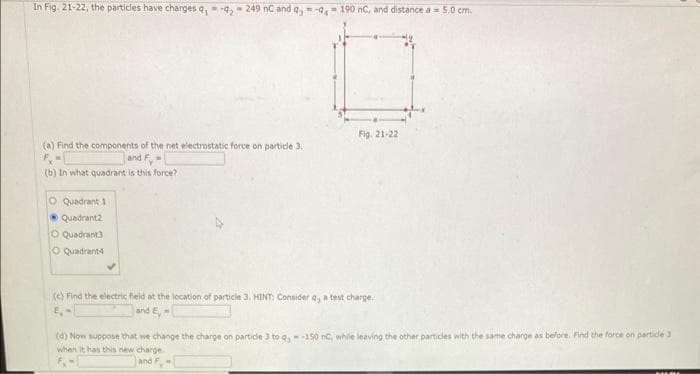In Fig. 21-22, the particles have charges q, q,- 249 nC and q,-94-190 nC, and distance a-5,0 cm. (a) Find the components of the net electrostatic force on particle 3. F. - and F (b) In what quadrant is this force? O Quadrant 1 Quadrant2 O Quadrant3 O Quadrant4 Fig. 21-22 (c) Find the electric field at the location of particle 3. HINT: Consider a, a test charge. and E, (d) Now suppose that we change the charge on particle 3 to q-150 nC, while leaving the other particles with the same charge as before. Find the force on particle 3 when it has this new charge... and /
In Fig. 21-22, the particles have charges q, q,- 249 nC and q,-94-190 nC, and distance a-5,0 cm. (a) Find the components of the net electrostatic force on particle 3. F. - and F (b) In what quadrant is this force? O Quadrant 1 Quadrant2 O Quadrant3 O Quadrant4 Fig. 21-22 (c) Find the electric field at the location of particle 3. HINT: Consider a, a test charge. and E, (d) Now suppose that we change the charge on particle 3 to q-150 nC, while leaving the other particles with the same charge as before. Find the force on particle 3 when it has this new charge... and /
Related questions
Question
Pls asap

Transcribed Image Text:In Fig. 21-22, the particles have charges q₁ q2 249 nC and q,-9, 190 nC, and distance a 5.0 cm.
(a) Find the components of the net electrostatic force on particle 3.
and F-
(b) In what quadrant is this force?
O Quadrant 1
Quadrant2
O Quadrant3
O Quadrant4
Fig. 21-22
(c) Find the electric field at the location of particle 3. HINT: Consider a, a test charge.
and E,-
(d) Now suppose that we change the charge on particle 3 to q-150 nC, while leaving the other particles with the same charge as before. Find the force on particle 3
when it has this new charge...
and F
Expert Solution
This question has been solved!
Explore an expertly crafted, step-by-step solution for a thorough understanding of key concepts.
Step by step
Solved in 4 steps with 1 images
